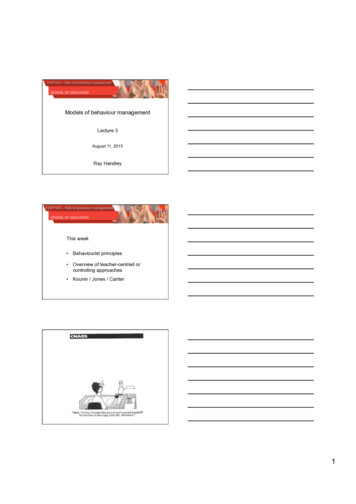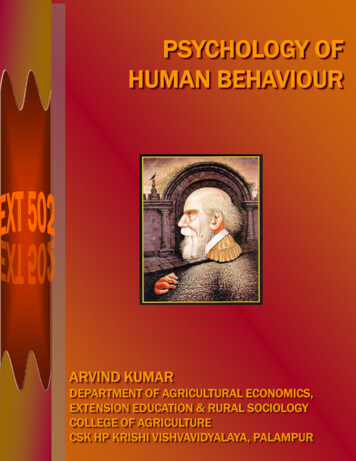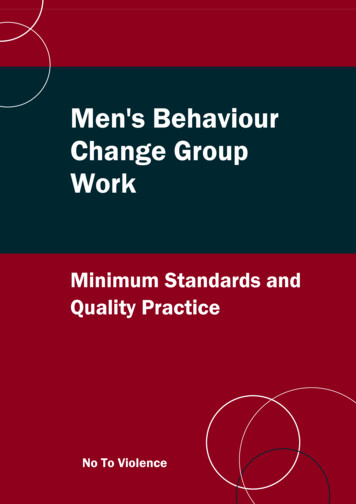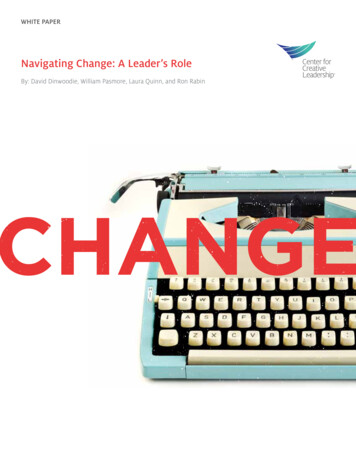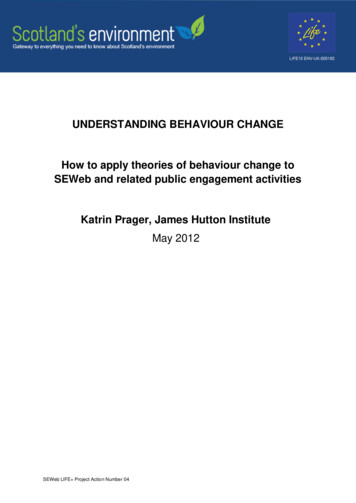
Transcription
UNDERSTANDING BEHAVIOUR CHANGEHow to apply theories of behaviour change toSEWeb and related public engagement activitiesKatrin Prager, James Hutton InstituteMay 2012SEWeb LIFE Project Action Number 04
Understanding behaviour changeHow to apply theories of behaviour change to SEWeband related public engagement activitiesKatrin Prager, James Hutton Institutekatrin.prager@hutton.ac.ukReport for SEWeb LIFE10 ENV-UK-000182May 2012
Katrin PragerTheories of Behaviour ChangeApril 2012Contents1.Introduction. 52.Social-psychological theories of behaviour and change . 72.1Rational Choice . 72.2Theory of Reasoned Action & Theory of Planned Behaviour . 82.3Value-Belief-Norm Theory & Theory of Interpersonal Behaviour . 82.4Persuasion theory . 102.4.1Beginnings . 102.4.2Elaboration Likelihood Model . 102.5Social learning theory, and what motivates people to learn. 112.6Community-based Social Marketing & Adoption Theory. 123.Summary . 164.Recommendations . 175.4.1How can policy influence behaviours . 174.2How can SEWeb influence behaviours . 18References . 20Appendices. 223
Katrin PragerTheories of Behaviour ChangeApril 2012ForewordThis report is written to help partners involved in the development of Scotland’s EnvironmentWebsite (SEWeb) to better understand what motivates behaviour and how behaviours can beinfluenced. A draft of this report was presented to and discussed with a small group of SEWebpartners on 22 March 2012, and subsequently revised. The final report is to be presented at theworkshop on “What can theory tell us about behaviour change through policy and SEWeb” (plannedfor June 2012). An Annex will capture the feedback received and any output generated at theworkshop in order to complement the report.The theories discussed here are also applicable to the broader suite of environmental policies sinceenvironmental protection and improved environmental management, through communication,policy and planning, often ultimately requires changes in behaviour for effective implementation.The aim is to achieve policy impact and to make a lasting difference on the ground, based on anunderstanding of the principles of behaviour change.The aim of the research programme underlying the public engagement work stream of the SEWebproject is to test the hypothesis that better on-line information about the environment (both interms of what information people need and how they need it presented) supports the move toincreased engagement in debating environmental priorities, monitoring the environment andtaking action to protect it (or, put differently, the ultimate purpose of the provision ofenvironmental information is to stimulate behaviour change to better appreciate, use, manage andprotect the environment).4
Katrin PragerTheories of Behaviour ChangeApril 20121. Introduction“Policy development in the context of behavioural change is notoriously difficult.”(Jackson, 2005, 3)“The sheer complexity of human behaviours and motivations makes it very hardto predict with certainty what the impacts of policy interventions on people’sbehaviour are going to be.” (Jackson, 2005, 119)The importance of influencing behaviour in order to achieve positive policy outcomes is increasinglyrecognised and has led to a number of reviews and reports. Some of these cover the use ofbehaviour change models in general (Darnton, 2008b) while others focus on behaviours relevant tospecific contexts such as climate change (Southerton et al., 2011), sustainable consumption (Jackson,2005), or the impact of volunteering on environmental behaviour (Hine et al., 2008).Behavioural theories and models of behavioural change cannot bring about behaviour change, norcan they predict with certainty what changes in behaviour will occur. Nevertheless, they can informpolicy makers, implementers and others involved in trying to bring about change about the issues toconsider and the likely success of initiatives and interventions. This report aims to aid theunderstanding why and how behaviour change occurs and what the factors and conditions are thatdrive behaviours.As Michie et al. (2008) note, “theory provides a helpful basis for designing interventions to changebehaviour but offers little guidance on how to do this”. The authors go on to develop an extensivelist of behaviour change techniques (with definitions) and link the techniques to theoreticalconstructs. However, even though they outline the possibility of developing a comprehensive,reliable taxonomy of techniques linked to theory, there still is no guidance on how a policy maker oranyone else wishing to influence, for example, environmental behaviour would pick the relevanttechniques. This report tries to provide readers with a better understanding of the mechanisms andprocesses that underlie human behaviour in order to then decide on which approaches are suitableto achieve behaviour change.1Before embarking on a discussion around what theories of behavioural change can tell us about thebest way to influence behaviour, those wishing to change behaviour need to answer the followingquestions:1. Whose behaviour should be changed?2. What behaviour should be changed?3. What change do we wish to see and how can we tell that it has happened?1Recent notions in a number of government bodies and agencies have been to avoid the term ‘behaviourchange’ because it is associated with a top-down, psychological imperative, something imposed bygovernment (Paul Tyrer, by email, 19 March 2012). Therefore, I preferred the term ‘influence’ over ‘change’but this could not be done consistently because the body of theories is explicitly built around the term‘behaviour change’.5
Katrin PragerTheories of Behaviour ChangeApril 20124. Why should these behaviours change?There are a few highlights from a broad range of theories2 that need to be kept in mind wheneverdesigning tools or policy interventions to influence behaviour. As Kathryn Mearns (2012) pointedout, behaviour is very resistant to change:People are creatures of habit, and we try to achieve maximum gain with minimum effort;Information and exhortation are among the least effective ways of influencing behaviour(Bandura, 1977; Campbell, 1963), even if people are informed about health risks (e.g.smoking, obesity);We are focused on the short-term not the long-term (immediate survival was critical for ourancestors; in contrast, the very gradual, slow pace of environmental change represents acognitive barrier (Kollmuss and Agyeman, 2002));We do not necessarily respond well to being told what to do (related to ideas of personalfreedom/rights especially in Western societies (Branson et al., 2012)).It is important to distinguish between two types of theories. Some theories and models are wellsuited for a heuristic (comprehensive, conceptual) understanding of behaviours. They are able tocapture the wide variety of different factors3 that influence choices and behaviours and fulfil aconceptual role. However, these complex models are not necessarily good for empirical testing.They are too complex to allow for obtaining quantitative evidence about real attitudes andbehaviours.2Note that the terms theory, model, theoretical construct, theoretical framework are often usedinterchangeably. This report generally uses the terms employed by the respective authors.3Choices are influenced by moral, normative, emotional, social factors, as well as facilitating conditions andthe force of habit, and the (so-called) rational deliberations and intentions (Jackson 2005, 105)6
Katrin PragerTheories of Behaviour ChangeApril 2012Figure 1: Overview of behavioural change theories (figure by K.Prager)When starting to look at the theoretical grounding for behaviour change, another distinction can beobserved. One the one hand, there is a wealth of models of behaviour that explain why people makecertain decisions and display certain behaviours. They focus on describing existing behaviour, e.g.how intentions, attitudes, values and other factors shape behaviour (Figure 1, left side). On theother hand are theories that focus on how to change behaviour from one behaviour to another,more desired behaviour (Figure 1, right side). This second set of theories draws on a number ofbehavioural models in order to explain how to change behaviours. In practice, both kinds of theoriescan help identify points of policy interventions or how to target initiatives aimed at influencingbehaviour.Models of behaviour (left side of Figure 1) can be split into those focusing on individual perspectivesexplaining behaviour as determined by internal factors (dominant in psychology), and thosefocussing on behaviour determinants external to the individual (dominant in sociology, economics,political sciences). More recent theories try to incorporate internal and external factors, subsumedunder ‘integrative theories of behaviour’. The latter are particularly useful since behaviour changeneeds both, attention to influencing individuals’ behaviour and changing the conditions and driverswhich influence behaviours.2. Social-psychological theories of behaviour and changeTim Jackson (2005), in his review of evidence on consumer behaviour and behavioural change, lists atotal of 22 different theories and models that explain people’s behaviour. Andrew Darnton (2008a)reviews over 60 social-psychological models and theories of behaviour. Darnton’s focus is broaderand looks at all kinds of behaviour change while Jackson’s review takes the perspective of consumerbehaviour, marketing and advertising. The relevant theories also apply when the aim is to get peopleinvolved in monitoring and environmental action.2.1Rational ChoiceRational choice theory is often not recognised as one coherent theory but it is a widespread way ofthinking about behaviour and it is also deeply entrenched in institutions and policies of modern(Western) societies. It draws on the intellectual underpinnings of classical economics. Rationalchoice theory claims that people behave in such a way as to maximise the expected benefits toourselves as individuals from our actions. Shortcomings of this theory are that it assumes we havecomplete information about the costs, benefits and impact of our actions. Further developments ofthis theory to apply to non-purchasing behaviour include the notion that choices are influenced byboth, financial and non-financial costs and benefits to the individual. In addition, the literaturesuggests that “only a limited proportion of pro-environmental behaviour can be regarded as flowingfrom fundamentally self-interested value-orientations” (Jackson, 2005, 32). Examples are altruistic,pro-social and biopheric4 value orientations that explain why some pro-environmental behavioursstill occur even though they incur private costs to those who engage in them.There has been a tendency among rational choice theorists to denigrate habitual behaviour asirrational, however, others point out that habits have considerable benefits to human functioning4Concern for the biosphere7
Katrin PragerTheories of Behaviour ChangeApril 2012(e.g. I don’t need to think about every situation anew but rely on what has worked in the past) andcan be considered part of procedural rationality.2.2Theory of Reasoned Action & Theory of Planned BehaviourBoth, the theory of reasoned action and the theory of planned behaviour date back several decadesand have been continuously developed. Although critics argue they are outdated, the more recenttheories of behaviour change still draw on some aspects of these two theories.The theory of reasoned action is perhaps the best-known social-psychological attitude-behaviourmodel and incorporates external factors (normative social influences) on behavioural intention(Ajzen and Fishbein, 1980). The theory of planned behaviour (Ajzen, 1991) adjusts the earlier theoryto incorporate the actor’s perceived control over the outcome of his/her behaviour. The underlyingassumption is that humans are rational and make systematic use of available information.Note that this theory looks at intentions rather than actual behaviour. The theory describes therelationship between attitudes – intentions – behaviour of an actor, and assumes that changes inawareness and intention lead to action. The ‘intentions to behave’ are explained from attitudes,social norms and perceived control. One strand of research emphasises the gap between intentionand behaviour (cf. Courtenay-Hall and Rogers, 2002)5 while another strand challenges the extent ofthe gap between value/attitudes and action (Maio, 2011). As Maio points out, the problem is notthat values and actions fail to correspond, but rather that values often fail to predict specificbehaviours very well.2.3Value-Belief-Norm Theory & Theory of InterpersonalBehaviourA premise of Stern’s value-belief-norm theory (Stern et al., 1999) is that pro-social attitudes andpersonal moral norms are significant predictors of pro-environmental behaviour. This means that,people who undertake environmental action have at least some altruistic or moral reason for doingso, or they are motivated by self-serving interests (e.g. I may not care about the impact of myactions on others but may care about the expectations of others on me not to act in anti-socialways).Stern’s model starts from values, which form the basis for beliefs, which in turn underlie normswhich dictate behaviour. This means that depending on my values (altruistic, biospheric, egoistic) Iam more or less likely to accept that my behaviour impacts on the environment (I am aware ofpossible consequences and ascribe a certain responsibility to myself and my behaviour). Dependingon these beliefs about the impact of my behaviour I form a personal norm which then determinesmy behaviour, e.g. whether I become an active member in an NGO, support environmental policiesor change my private sphere behaviour (e.g. recycling).Evidence shows that a person with altruistic values is more likely to activate a pro-environmentalnorm, whereas self-enhancement (egoistic) values tend to be negatively correlated with proenvironmental norms and actions (Stern, 2000). The theory further suggests that behaviour depends5These authors also explore numerous other gaps such as the ‘conscious - non-conscious gap’ (tied to reasonand habit in moral agency) or the ‘direct action - indirect action gap’ (tied to privatizing environmentalmorality).8
Katrin PragerTheories of Behaviour ChangeApril 2012critically on the salience of specific beliefs and values in specific contexts, and that different valueorientations can co-exist in the same individual and may all influence behaviour.Problematic is the weak correlation between personal norms and indicators of pro-environmentalbehaviour found in empirical studies. This means that while values are of some importance inmotivating (or predicting) environmental action, the situational and contextual factors play aconsiderable role (see also Maio 2011).Stern (2000) attempted to integrate internal and external factors influencing behaviour in ‘attitudebehaviour-context’ models. Although he acknowledged that in addition to the three factors(attitudes, contextual factors, personal capabilities) the role of habit must be included, he did notdevelop a theory to reflect this. Looking at the body of available theory we find that Triandis’ theoryof interpersonal behaviour is an example where the behaviour-mediating role of habit is considered(Triandis, 1977). He also offers an explicit role for affective factors on behavioural intentions, andhighlights the facilitating conditions which must allow intentions to become realised (Figure 2). Thisextends previous models (but note that this does not necessarily mean chronologically precedingmodels).Beliefs ion ofoutcomesNormsRolesSocial tFrequency ofpast behaviourHabitsFigure 2: Triandis’s Theory of Interpersonal Behaviour (source: Jackson 2005, 94)9
Katrin Prager2.4Theories of Behaviour ChangeApril 2012Persuasion theory2.4.1 BeginningsEarly beginnings of persuasion theory claim that successful persuasion hinges on three key elements(Hovland et al., 1953):The credibility of the speaker (the source);The persuasiveness of the arguments (the message); andThe responsiveness of the audience (the recipient).The model assumes that exposure to information leads to a change in attitude which in turn leads toa change in behaviour. Many past and recent public information campaigns are based on this‘information-deficit-model’ where the underlying assumption is that people do not have enough (orthe right) information, so if we provide more information this will enable them to change theirbehaviour (or make ‘the right’ or reasonable decisions). Although it sounds plausible, empiricalevidence fails to support this hypothesis and significant limitations of this linear model have beenrecognised (McKenzie-Mohr, 2000; Petty et al., 2002)6. On the contrary, evidence suggests thatlearning (i.e. change in behaviour) can occur without any change in attitudes, and that attitude (andbehaviour) change can occur without any assimilation of the persuasion message (further referencesin Jackson, 2005, 106).Despite the limitations of this theory, the importance of the key elements still appears in behaviour,in particular land manager behaviour. For farmers it has been shown that the source of advice (e.g.the farm advisor and the organisation they belong to) and the persuasiveness of the arguments arejust as important in taking up advice as other factors (Juntti and Potter, 2002; Silgo and Massey,2007; Vanclay, 2004).2.4.2 Elaboration Likelihood ModelThe Elaboration Likelihood Model is one of the most influential recent persuasion theories (Pettyand Cacioppo, 1981, 1986). It suggests that there are two types of psychological processes involvedin attitude change, one taking the route of central processing and one taking the route of peripheralprocessing.7If the target audience’s motivation or ability to engage with the message is low, the peripheral routewill be employed. This may either lead directly to a behaviour change, or first to an attitude changewhich is then followed by a behaviour change.In cases where an individual is highly motivated and pays mindful attention, the message will bepassed through the central processing route. If this route is taken, an enduring attitude change(leading on to behaviour change) is more likely.A number of recommendations for successful persuasion can be taken from this theory:It is important to use personally involving messages (as this is more likely to lead toutilisation of the central processing route) with an emotional and imaginative appeal6McKenzie-Mohr found in their experiment that the social marketing strategy led to a reduced watering oflawns by 54%, whereas it increased by 15% over the same period in the information-only control group.7More detail in Jackson (2005), pages 107f.10
Katrin PragerTheories of Behaviour ChangeApril 2012The message should be immediately relevant and directUse a single, well-placed message and one that is very positive (in particular in our messagedense environment, and in order to increase the likelihood that the target audience willutilise the central processing route)Persuasive appeals must employ highly credible sources (see also the key elements of earlypersuasion theory)Use commitments (bumper stickers, badges, loyalty schemes) to signal involvementIdentify ‘retrieval cues’, i.e. things that will help people bring the persuasive message tomind and remind them (references in Jackson, 2005, 109)In general, this demands very careful attention to the target audience, knowing their needs anddemands as well as what might constitute barriers for them to translate attitudes into behaviour.2.5Social learning theory, and what motivates people to learn“The key lesson from theory and the related empirical evidence base is that social learning is apowerful avenue of behavioural change” (Jackson, 2005, 112). Social learning theory highlights thecritical role that governments play in providing leadership on environmental behaviours. Failure toexemplify the behavioural changes that policy wishes to see will significantly undermine anyinformation and persuasion campaigns. For example, if agencies are not perceived to be seriousabout saving paper and water, why should Joe Public care to do so?Social learning theory (Bandura, 1977) stresses thatWe learn by trial and error. Whether we receive a reward or a punishment will determinehow we decide to behave the next time round. Rewards can be financial and non-financial,they can come in the form of material goods or in the form of satisfying altruisticmotivations (see rational choice in Section 2.1).We learn by observing how others behave (we learn by imitation but also by counterexamples, e.g. parents, peers, those portrayed in the media) and by modelling our ownbehaviour on what others do and what we see around us.Note that stealth marketing (involving strategies such as viral marketing and celebrity marketing)draws heavily on ideas of social learning theory. For example, identity-related buying behaviours(cars, appliances) but also whether or not to become involved in environmental activities “areinfluenced by those on whom my identity is modelled and by those from whom I am hoping todistinguish myself” (Jackson, 2005, 111). While policies aiming to further environmental action cansurely learn from these kinds of approaches they also raise difficult ethical and moral issues, e.g. towhat extent policies can prescribe what is ‘right’ now, what choices are ‘good’ or to what extentindividuals are entitled to make free choices.Related to the point made at the outset or the report that ‘people do not like being told what to do’are insights by Kaplan and Kaplan (1989) on the information processing and problem-solvingpropensities of humans. People are motivated:To know and understand what is going on: they hate being disoriented or confused;To learn, discover and explore: they prefer acquiring information at their own pace andanswering their own questions;11
Katrin PragerTheories of Behaviour ChangeApril 2012To participate and play a role in what is going on around them: they hate feelingincompetent or helpless.In a similar vein, Albert Bandura developed a social cognitive theory throughout the 1980s and1990s which explains human behaviour through a mix of cognitive, vicarious, self-regulatory andself-reflective processes geared towards human adaptation and change (Bandura, 1986), not just asreactive organisms shaped by environmental forces or driven by inner impulses. In outliningprinciples for behaviour change Bandura emphasises self-efficacy which is derived from a)performance accomplishments (mastery), b) vicarious experience (feelings based on the experienceof someone else), c) verbal persuasion, and d) physiological states (Bandura, 1997).While these considerations indicate that online information portals such as SEWeb may incentivisepeople to learn and discover, they also highlight the challenge of how to involve people. It is likelythat people do not feel they can participate and play a role in the website, or the way they are beinginvolved does not appeal to them. A website could be seen as remote, theoretical and non-personalwhile a share of the population may prefer hands-on, practical approaches with the opportunity forsocialising.Importantly again, in addition to the observation that information on its own rarely leads to attitudeor behaviour change, an overload of information may lead to feelings of confusion and helplessnessrather than providing orientation or increasing the feeling of control (Kaplan, 2000; Levin, 1993). Sowhile we would hope that increasing the levels of information e.g. about environmental problemswill make people become more active in protecting the environment, they may actually beoverwhelmed and be paralysed by not knowing where to start or doubting whether they can make acontribution at all (further references in Jackson, 2005, 113). This reasoning draws on the ‘perceivedbehaviour control’ construct in the theory of planned behaviour.2.6Community-based Social Marketing & Adoption TheoryIt is helpful to make a distinction between influencing ‘one-off behaviour’ and ‘routine behaviour’.One-off behaviour is related to a decision which needs to be made only once such as the decision tobuy an energy-efficient refrigerator or participation in an event to clean up the local park. Routinebehaviour is much more difficult to influence (see also discussion on ‘breaking bad habits’ in Jackson(2005)). A promising approach to encourage pro-environmental behaviour change is communitybased social marketing.Community-based social marketing is an approach to policy design which begins with understandingthe barriers that people perceive when attempting to engage in a given activity, and integrates theimportance of social norms and community engagement in changing behaviours (McKenzie-Mohr,2000). It follows four consecutive steps: 1) selecting behaviours and identifying barriers; 2) designinga programme to overcome barriers to the selected behaviour; 3) piloting the programme; and 4)evaluation.It is important that rather than attempting to promote all possible behaviours to achieve a certain(e.g. environmental) goal, the first step is to identify the barriers to such behaviour, and then toselect a specific behaviour to promote. The selection of the behaviour to promote could, forexample, be based on what resources are required to overcome the barriers: if this turns out to betoo costly or too resource-intensive, another behaviour might be selected.12
Katrin PragerTheories of Behaviour ChangeApril 2012This approach resembles the ‘process of adoption’ described for land manager adoption of soil andwater conservation practices (Prager and Posthumus, 2010). The decision making and behaviour inparticular of farmers has been widely studied and it is recognised that personal, social, cultural,economic (market), and institutional (policy) factors are influential. A precise ranking of the relevantfactors is not possible as their influence will vary across individuals and their context, as well as overtime and with the specific behaviour to be promoted.Figure 3 depicts the process for a farmer or other land manager in relation to soil degradationproblems. However, it can also be applied to thinking about how to achieve behaviour changeamong the public. The first phase is the awareness of a problem and possible solutions. Theindividual’s perception of a problem is at the beginning of the process. Take the example of a parttime working mother of two children. She is convinced that playing outdoors is important for thechildren’s healthy development. Therefore, she takes her children to the local greenspace which hasa burn running through it but she is annoyed with the amount of rubbish. Only if she perceives theproblem as urgent, and is concerned about negative consequences if the problem is left untreated(e.g. her children getting cuts from broken glass bottles), will she consider acting on the issue. Theissue must also be relevant to the individual’s current well-being (the mother wants to be sure herchildren are safe). Only if these conditions are met will the mother be willing to invest her time insearching for a solution.The second phase is that the individual is not only willing but also assesses that he/she is able to act.The mother must be aware of options (possible behaviours) that she considers suitable to mitigatethe problem. If she is convinced that cleaning up the park is the council’s responsibility but thecouncil have not responded to her letters, she might give up here. If, however, the mother knows alocal community group and gets along well with some of the members she might raise the issuethere and the group might organise monthly clean-up days.The third phase comprises trialling and adopting the new behaviour. Because the mother has thesupport of her husband on the weekends and is happy to help out, the whole family decides to joinone of the clean-up days (trialling behaviour). If they find that the timing is right and does notinterfere with other commitments, they like the company of the other people, and the weather ispleasant, they will be much more inclined to join in again. The family may need to adapt existingroutines (e.g. g
policy and planning, often ultimately requires changes in behaviour for effective implementation. The aim is to achieve policy impact and to make a lasting difference on the ground, based on an understanding of the principles of behaviour change. The aim of the research programme




